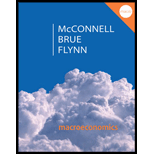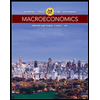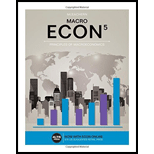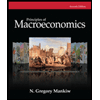
Concept explainers
Subpart (a):
Balance sheet .
Subpart (a):
Explanation of Solution
The
The excess reserves are evaluated as follows:
$2,000 is the excess reserve, so the increase in loans is $2,000. Initially, securities and reserves do not change. The people who have borrowed money will have the same amount that will be credited to his or her account for the loan taken, once the loan is made by the bank. So, there will be a rise in checkable deposits for $2,000. Hence, $2000 is the utmost amount of loans that can be made by Big Bucks Bank
Table -1 illustrates the balance sheet of the bank after lending extra money.
Table -1
| Assets | Liabilities and net worth | ||||
|
(1) |
(1) | ||||
| Reserves | $22,000 | $22,000 | Checkable Deposits | $100,000 | $102,000 |
| Securities | 38,000 | 38,000 | |||
| Loans | 40,000 | 42,000 | |||
Concept Introduction:
Balance sheet: Itis a financial statement that encapsulates organizations’ assets, their liabilities and equity of the shareholders at a particular point in time.
Subpart (b):
Rise in money supply.
Subpart (b):
Explanation of Solution
There is a rise of $2,000 in checkable deposits. A monetary multiplier is not considered till now, so transaction has an immediate effect which is a $2,000 rise in the supply of money.
Subpart (c):
Balance sheet.
Subpart (c):
Explanation of Solution
Table -2 illustrates the new balance sheet.
Table -2
| Assets | Liabilities and net worth | ||||||||||
| (1) | (1) | (2) | |||||||||
| Reserves | $22,00 | $22,000 | $20,000 | Checkable deposits | $100,000 | $102,000 | $100,000 | ||||
| Securities | 38,000 | 38,000 | 38,000 | ||||||||
| Loans | 40,000 | 42,000 | 42,000 | ||||||||
Once the checks against the loan are drawn, there will be a fall of $2,000 in checkable deposits. Once these checks are cleared, the reserves go down by $2,000.
Concept Introduction:
Balance sheet: Itis a financial statement that encapsulates organizations’ assets, their liabilities and equity of the shareholders at a particular point in time.
Subpart (d):
Balance sheet.
Subpart (d):
Explanation of Solution
On the basis of sub part (a), the required reserves are evaluated as follows:
Hence, the required reserves are $15,000.
Excess Reserves are evaluated as follows:
Hence, the excess reserves are $7,000.
$7,000 is the excess reserve, so the increase in loans is $7,000. Initially, securities and reserves do not change. The people who have borrowed money will have the same amount that will be credited to his or her account for the loan taken once the loan is made by the bank. So, there will be a rise in checkable deposits for $7,000.
Table -3 shows the bank’s balance sheet will appear after the bank has lent this additional amount and is obtained from the given diagram.
Table-3
| Assets | Liabilities and net worth | ||||
| (1) | (1) | ||||
| Reserves | $22,000 | $22,000 | Checkable Deposits | $100,000 | $107,000 |
| Securities | 38,000 | 38,000 | |||
| Loans | 40,000 | 47,000 | |||
On the basis of sub part (b), there is a rise of $7,000 in checkable deposits. Monetary multiplier is not considered till now, so the transaction has an immediate effect which is a $7,000 rise in supply of money.
On the basis of sub part (c), once the checks against the loan are drawn, there will be a fall of $7,000 in checkable deposits. Once these checks are cleared, the reserves go down by $7,000.
Table -4 shows the new balance sheet that is illustrated below.
Table -4
| Assets | Liabilities and net worth | ||||||||||
| (1) | (1) | (2) | |||||||||
| Reserves | $22,00 | $22,000 | $20,000 | Checkable deposits | $100,000 | $107,000 | $100,000 | ||||
| Securities | 38,000 | 38,000 | 38,000 | ||||||||
| Loans | 40,000 | 47,000 | 47,000 | ||||||||
Concept Introduction:
Balance sheet: Itis a financial statement that encapsulates organizations’ assets, their liabilities and equity of the shareholders at a particular point in time.
Want to see more full solutions like this?
Chapter 15 Solutions
Macroeconomics: Principles, Problems, & Policies
- 19. In a paragraph, no bullet, points please answer the question and follow the instructions. Give only the solution: Use the Feynman technique throughout. Assume that you’re explaining the answer to someone who doesn’t know the topic at all. How does the Federal Reserve currently get the federal funds rate where they want it to be?arrow_forward18. In a paragraph, no bullet, points please answer the question and follow the instructions. Give only the solution: Use the Feynman technique throughout. Assume that you’re explaining the answer to someone who doesn’t know the topic at all. Carefully compare and contrast fiscal policy and monetary policy.arrow_forward15. In a paragraph, no bullet, points please answer the question and follow the instructions. Give only the solution: Use the Feynman technique throughout. Assume that you’re explaining the answer to someone who doesn’t know the topic at all. What are the common arguments for and against high levels of federal debt?arrow_forward
- 17. In a paragraph, no bullet, points please answer the question and follow the instructions. Give only the solution: Use the Feynman technique throughout. Assume that you’re explaining the answer to someone who doesn’t know the topic at all. Explain the difference between present value and future value. Be sure to use and explain the mathematical formulas for both. How does one interpret these formulas?arrow_forward12. Give the solution: Use the Feynman technique throughout. Assume that you’re explaining the answer to someone who doesn’t know the topic at all. Show and carefully explain the Taylor rule and all of its components, used as a monetary policy guide.arrow_forward20. In a paragraph, no bullet, points please answer the question and follow the instructions. Give only the solution: Use the Feynman technique throughout. Assume that you’re explaining the answer to someone who doesn’t know the topic at all. What is meant by the Federal Reserve’s new term “ample reserves”? What may be hidden in this new formulation by the Fed?arrow_forward
- 14. In a paragraph, no bullet, points please answer the question and follow the instructions. Give only the solution: Use the Feynman technique throughout. Assume that you’re explaining the answer to someone who doesn’t know the topic at all. What is the Keynesian view of fiscal policy and why are some economists skeptical?arrow_forward16. In a paragraph, no bullet, points please answer the question and follow the instructions. Give only the solution: Use the Feynman technique throughout. Assume that you’re explaining the answer to someone who doesn’t know the topic at all. Describe a bond or Treasury security. What are its components and what do they mean?arrow_forward13. In a paragraph, no bullet, points please answer the question and follow the instructions. Give only the solution: Use the Feynman technique throughout. Assume that you’re explaining the answer to someone who doesn’t know the topic at all. Where does the government get its funds that it spends? What is the difference between federal debt and federal deficit?arrow_forward
- 11. In a paragraph, no bullet, points please answer the question and follow the instructions. Give only the solution: Use the Feynman technique throughout. Assume that you’re explaining the answer to someone who doesn’t know the topic at all. Why is determining the precise interest rate target so difficult for the Fed?arrow_forwardProblem 1 Regression Discontinuity In the beginning of covid, the US government distributed covid stimulus payments. Suppose you are interested in the effect of receiving the full amount of the first stimulus payment on the total spending in dollars by single individuals in the month after receiving the payment. Single individuals with annual income below $75,00 received the full amount of the stimulus payment. You decide to use Regression Discontinuity to answer this question. The graph below shows the RD model. 3150 3100 3050 Total Spending in the month after receiving the stimulus payment 2950 3000 74000 74500 75000 75500 76000 Annual income a. What is the outcome? (5 points) b. What is the treatment? (5 points) C. What is the running variable? (5 points) d. What is the cutoff? (5 points) e. Who is in the treatment group and who is in the control group? (10 points) f. What is the discontinuity in the graph and how do you interpret it? (10 points) g. Explain a scenario which can…arrow_forwardProblem 2 Difference-in-Difference In the beginning of 2005, Minnesota increased the sales tax on alcohol. Suppose you are interested in studying the effect of the increase in sale taxes on alcohol on the number of car accidents due to drinking in Minnesota. Unlike Minnesota, Wisconsin did not change the sales tax on alcohol. You decide to use a Difference-in-difference (DID) Model. The numbers of car accidents in each state at the end of 2004 and 2005 are as follows: Year Number of car accidents in Minnesota Number of car accidents in Wisconsin 2004 2000 2500 2005 2500 3500 a. Which state is the treatment state and which state is the control state? (10 points) b. What is the change in the outcome for the treatment group between 2004 and 2005? (5 points) C. Can we interpret the change in the outcome for the treatment group between 2004 and 2005 as the causal effect of the policy on car accidents? Explain your answer. (10 points) d. What is the change in the outcome for the control…arrow_forward
 Macroeconomics: Private and Public Choice (MindTa...EconomicsISBN:9781305506756Author:James D. Gwartney, Richard L. Stroup, Russell S. Sobel, David A. MacphersonPublisher:Cengage Learning
Macroeconomics: Private and Public Choice (MindTa...EconomicsISBN:9781305506756Author:James D. Gwartney, Richard L. Stroup, Russell S. Sobel, David A. MacphersonPublisher:Cengage Learning Economics: Private and Public Choice (MindTap Cou...EconomicsISBN:9781305506725Author:James D. Gwartney, Richard L. Stroup, Russell S. Sobel, David A. MacphersonPublisher:Cengage Learning
Economics: Private and Public Choice (MindTap Cou...EconomicsISBN:9781305506725Author:James D. Gwartney, Richard L. Stroup, Russell S. Sobel, David A. MacphersonPublisher:Cengage Learning
 Essentials of Economics (MindTap Course List)EconomicsISBN:9781337091992Author:N. Gregory MankiwPublisher:Cengage Learning
Essentials of Economics (MindTap Course List)EconomicsISBN:9781337091992Author:N. Gregory MankiwPublisher:Cengage Learning Principles of Economics (MindTap Course List)EconomicsISBN:9781305585126Author:N. Gregory MankiwPublisher:Cengage Learning
Principles of Economics (MindTap Course List)EconomicsISBN:9781305585126Author:N. Gregory MankiwPublisher:Cengage Learning Principles of Macroeconomics (MindTap Course List)EconomicsISBN:9781285165912Author:N. Gregory MankiwPublisher:Cengage Learning
Principles of Macroeconomics (MindTap Course List)EconomicsISBN:9781285165912Author:N. Gregory MankiwPublisher:Cengage Learning





